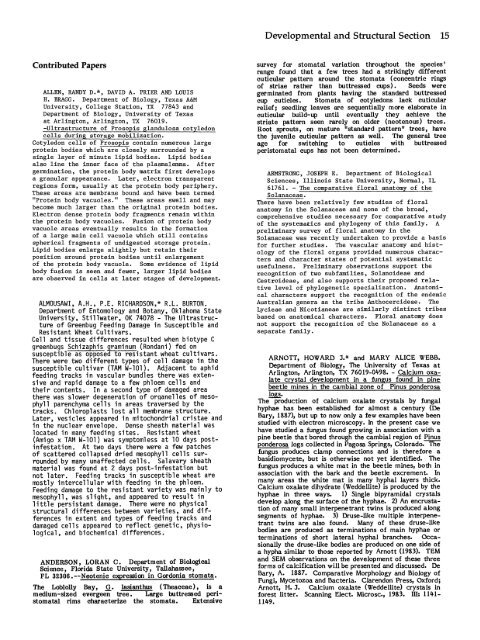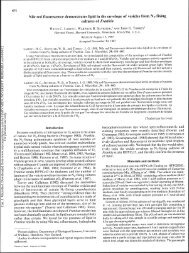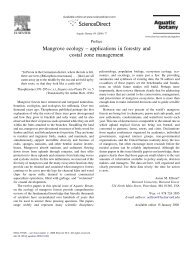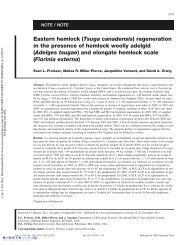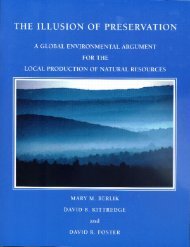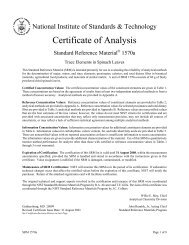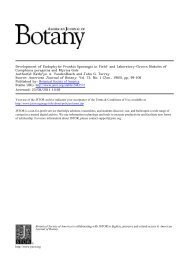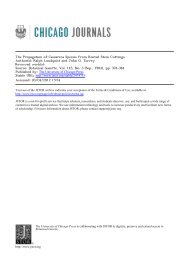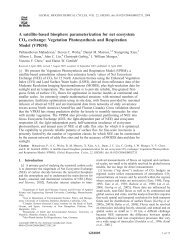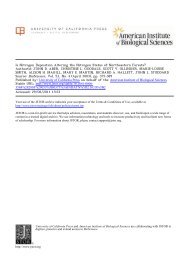Abstracts of Papers - Harvard Forest - Harvard University
Abstracts of Papers - Harvard Forest - Harvard University
Abstracts of Papers - Harvard Forest - Harvard University
Create successful ePaper yourself
Turn your PDF publications into a flip-book with our unique Google optimized e-Paper software.
Contributed <strong>Papers</strong><br />
ALLEN, RANDY D.*, DAVID A. PRIER AND LOUIS<br />
H. BRAGG. Department <strong>of</strong> Biology, Texas A&M<br />
<strong>University</strong>, College Station, TX 77843 and<br />
Department <strong>of</strong> Biology, <strong>University</strong> <strong>of</strong> Texas<br />
at Arlington, Arlington, TX 76019.<br />
-Ultrastructure <strong>of</strong> Prosopis glandulosa cotyledon<br />
cells during storage mobilization.<br />
Cotyledon cells <strong>of</strong> Prosopis contain numerous large<br />
protein bodies which are closely surrounded by a<br />
single layer <strong>of</strong> minute lipid bodies. Lipid bodies<br />
also line the inner face <strong>of</strong> the plasmalemma. After<br />
germination, the protein body matrix first develops<br />
a granular appearance. Later, electron transparent<br />
regions form, usually at the protein body periphery.<br />
These areas are memibrane botnd and have been termed<br />
"Protein body vacuoles." These areas swell and may<br />
become much larger than the original protein bodies.<br />
Electron dense protein body fragments remain within<br />
the protein body vacuoles. Fusion <strong>of</strong> protein body<br />
vacuole areas eventually results in the formation<br />
<strong>of</strong> a large main cell vacuole which still contains<br />
spherical fragments <strong>of</strong> undigested storage protein.<br />
Lipid bodies enlarge slightly but retain their<br />
position around protein bodies until enlargement<br />
<strong>of</strong> the protein body vacuole. Some evidence <strong>of</strong> lipid<br />
body fusion is seen and fewer, larger lipid bodies<br />
are observed in cells at later stages <strong>of</strong> development.<br />
ALMOUSAWI, A.H., P.E. RICHARDSON,* R.L. BURTON.<br />
Department <strong>of</strong> Entomology and Botany, Oklahoma State<br />
<strong>University</strong>, Stillwater, OK 74078 - The Ultrastruc-<br />
ture <strong>of</strong> Greenbug Feeding Damage in Susceptible and<br />
Resistant Wheat Cultivars.<br />
Cell and tissue differences resulted when biotype C<br />
greenbugs Schizaphis graminum (Rondani) fed on<br />
susceptible as opposed to resistant wheat cultivars.<br />
There were two different types <strong>of</strong> cell damage in the<br />
susceptible cultivar (TAM W-101). Adjacent to aphid<br />
feeding tracks in vascular bundles there was exten-<br />
sive and rapid damage to a few phloem cells and<br />
their contents. In a second type <strong>of</strong> damaged area<br />
there was slower degeneration <strong>of</strong> organelles <strong>of</strong> meso-<br />
phyll parenchyma cells in areas traversed by the<br />
tracks. Chloroplasts lost all membrane structure.<br />
Later, vesicles appeared in mitochondrial cristae and<br />
in the nuclear envelope. Dense sheath material was<br />
located in many feeding sites. Resistant wheat<br />
(Amigo x TAM W-101) was symptomless at 10 days post-<br />
infestation. At two days there were a few patches<br />
<strong>of</strong> scattered collapsed dried mesophyll cells sur-<br />
rounded by many unaffected cells. Salavary sheath<br />
material was found at 2 days post-infestation but<br />
not later. Feeding tracks in susceptible wheat are<br />
mostly intercellular with feeding in the phloem.<br />
Feeding damage to the resistant variety was mainly to<br />
mesophyll, was slight, and appeared to result in<br />
little persistant damage. There were no physical<br />
structural differences between varieties, and dif-<br />
ferences in extent and types <strong>of</strong> feeding tracks and<br />
damaged cells appeared to reflect genetic, physio-<br />
logical, and biochemical differences.<br />
ANDERSON, LORAN C. Department <strong>of</strong> Biological<br />
Science, Florida State <strong>University</strong>, Tallahassee,<br />
FL 32306.--Neotenic expression in Gordonia stomata.<br />
The Loblolly Bay, G. lasianthus (Theaceae), is a<br />
medium-sized evergeen tree. Large buttressed peri-<br />
stomatal rims characterize the stomata. Extensive<br />
Developmental and Structural Section 15<br />
survey for stomatal variation throughout the species '<br />
range found that a few trees had a strikingly different<br />
cuticular pattern around the stomata (concentric rings<br />
<strong>of</strong> striae rather than buttressed cups). Seeds were<br />
germinated from plants having the standard buttressed<br />
cup cuticles. Stomata <strong>of</strong> cotyledons lack cuticular<br />
relief; seedling leaves are sequentially more elaborate in<br />
cuticular build-up until eventually they achieve the<br />
striate pattern seen rarely on older (neotenous) trees.<br />
Root sprouts, on mature "standard pattern" trees, have<br />
the juvenile cuticular pattern as well. The general tree<br />
age for switching to cuticles with buttressed<br />
peristomatal cups has not been determined.<br />
ARMSTRONG, JOSEPH E. Department <strong>of</strong> Biological<br />
Sciences, Illinois State <strong>University</strong>, Normal, IL<br />
61761. - The comparative floral anatomy <strong>of</strong> the<br />
Solanaceae.<br />
There have been relatively few studies <strong>of</strong> floral<br />
anatomy in the Solanaceae and none <strong>of</strong> the broad,<br />
comprehensive studies necessary for comparative study<br />
<strong>of</strong> the systematics and phylogeny <strong>of</strong> this family. A<br />
preliminary survey <strong>of</strong> floral anatomy in the<br />
Solanaceae was recently undertaken to provide a basis<br />
for further studies. The vascular anatomy and histology<br />
<strong>of</strong> the floral organs provided numerous characters<br />
and character states <strong>of</strong> potential systematic<br />
usefulness. Preliminary observations support the<br />
recognition <strong>of</strong> two subfamilies, Solanoideae and<br />
Cestroideae, and also supports their proposed relative<br />
level <strong>of</strong> phylogenetic specialization. Anatomical<br />
characters support the recognition <strong>of</strong> the endemic<br />
Australian genera as the tribe Anthocercideae. The<br />
Lycieae and Nicotianeae are similarly distinct tribes<br />
based on anatomical characters. Floral anatomy does<br />
not support the recognition <strong>of</strong> the Nolanaceae as a<br />
separate family.<br />
ARNOTT, HOWARD 3.* and MARY ALICE WEBB.<br />
Department <strong>of</strong> Biology, The <strong>University</strong> <strong>of</strong> Texas at<br />
Arlington, Arlington, TX 76019-0498. - Calcium oxa-<br />
late crystal development in a fungus found in pine<br />
beetle mines in the cambial zone <strong>of</strong> Pinus ponderosa<br />
The production <strong>of</strong> calcium oxalate crystals by fungal<br />
hyphae has been established for almost a century (De<br />
Bary, 1887), but up to now only a few examples have been<br />
studied with electron microscopy. In the present case we<br />
have studied a fungus found growing in association with a<br />
pine beetle that bored through the cambial region <strong>of</strong> Pinus<br />
ponderosa logs collected in Pagosa Springs, Colorado. The<br />
fungus produces clamp connections and is therefore a<br />
basidiomycete, but is otherwise not yet identified. The<br />
fungus produces a white mat in the beetle mines, both in<br />
association with the bark and the beetle excrement. In<br />
many areas the white mat is many hyphal layers thick.<br />
Calcium oxalate dihydrate (Weddellite) is produced by the<br />
hyphae in three ways. 1) Single bipyramidal crystals<br />
develop along the surface <strong>of</strong> the hyphae. 2) An encrusta-<br />
tion <strong>of</strong> many small interpenetrant twins is produced along<br />
segments <strong>of</strong> hyphae. 3) Druse-like multiple interpene-<br />
trant twins are also found. Many <strong>of</strong> these druse-like<br />
bodies are produced as terminations <strong>of</strong> main hyphae or<br />
terminations <strong>of</strong> short lateral hyphal branches. Occa-<br />
sionally the druse-like bodies are produced on one side <strong>of</strong><br />
a hypha similar to those reported by Arnott (1983). TEM<br />
and SEM observations on the development <strong>of</strong> these three<br />
forms <strong>of</strong> calcification will be presented and discussed. De<br />
Bary, A. 1887. Comparative Morphology and Biology <strong>of</strong><br />
Fungi, Mycetozoa and Bacteria. Clarendon Press, Oxford;<br />
Arnott, H. J. Calcium oxalate (Weddellite) crystals in<br />
forest litter. Scanning Elect. Microsc., 1983. III: 1141-<br />
1149.


